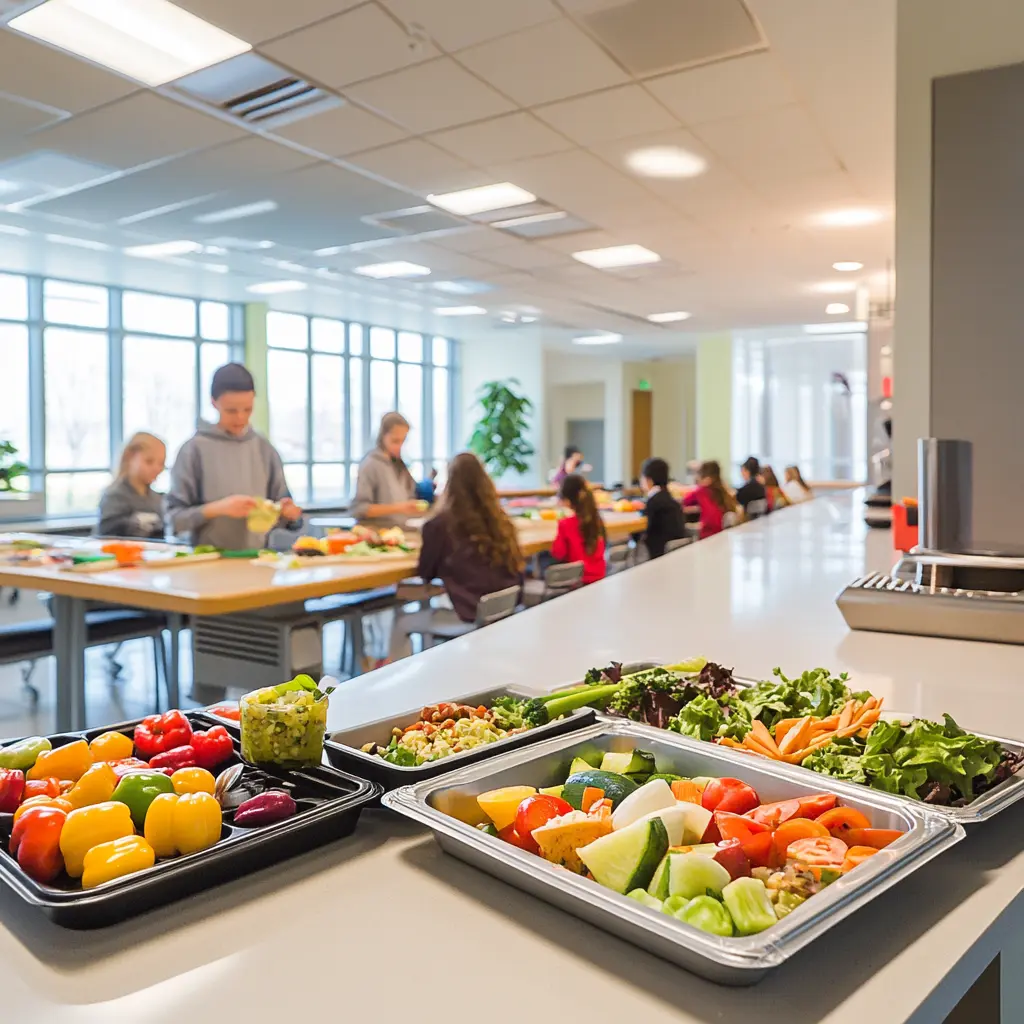A good school lunch is much more than just a midday meal; it’s a cornerstone of child health, education, and development. From nourishing growing bodies to influencing academic success, school lunches play a pivotal role in shaping brighter futures. This article dives deep into the significance of school lunch programs, exploring their history, challenges, innovations, and their role in promoting equity and sustainability.
Part 1: The Importance of School Lunch
Nutritional Benefits of School Lunch
Children’s diets today can be a battlefield of choices between nutritious meals and junk food. However, school lunch programs aim to bridge the gap by ensuring that students receive balanced meals rich in essential vitamins and nutrients. They help combat childhood obesity, boost immunity, and lay the foundation for lifelong healthy eating habits.
Fruits, vegetables, lean proteins, and whole grains often take center stage in these meals. These foods not only support physical growth but also improve mental clarity and concentration. As parents and educators work tirelessly to guide children towards better food choices, school lunches become a critical part of the equation.
Impact on Academic Performance
The saying “you are what you eat” rings particularly true when it comes to academic success. A healthy school lunch fuels the brain, improving memory, focus, and energy levels. Studies show that students who eat balanced meals perform better in standardized tests and exhibit fewer behavioral issues in the classroom.
Without adequate nutrition, children may face difficulties concentrating, leading to missed learning opportunities. Providing nourishing meals ensures every child, regardless of socioeconomic background, has the opportunity to thrive academically.
Social and Behavioral Aspects of School Meals
It’s not just about the nutrients—school lunches are also about community. Eating together fosters a sense of belonging, encouraging students to build relationships and engage in meaningful conversations. Additionally, learning table manners and practicing gratitude for food are life lessons subtly imparted during lunchtime.
Moreover, when children sit down to enjoy meals with peers, they are exposed to diverse food preferences and cultural dishes. This creates an environment of inclusivity and respect, which can translate to better social interactions both inside and outside the classroom.
Part 2: Historical Evolution of School Lunch Programs
Early Beginnings of School Lunch Programs
The origins of school lunch programs trace back to the late 19th century when the industrial revolution brought urbanization and widespread poverty. Schools became aware that many children were arriving hungry, unable to focus on their studies. Charity groups and social reformers began providing meals to address this issue.
For example, in Europe, countries like Germany and the United Kingdom introduced early feeding programs to ensure children’s nutritional needs were met during school hours. These initiatives not only nourished students but also inspired others to recognize the link between education and nutrition.
Development Through the 20th Century
The 20th century marked significant strides in school lunch initiatives. In the United States, the Great Depression spurred the government to formalize meal programs as part of broader efforts to combat poverty and unemployment. By 1946, the National School Lunch Act was established, making it a nationwide policy to provide low-cost or free meals to school children.
Similarly, other countries began refining their approaches. In Sweden, free school lunches became mandatory as early as the 1940s, emphasizing equal access to education and nutrition. Over time, these programs evolved to include stricter nutritional standards and more diverse food offerings.
Modern-Day School Lunch Programs
Fast forward to today, and school lunch programs are a cornerstone of education systems worldwide. Modern initiatives focus not only on providing enough calories but also on improving meal quality. Governments and non-profits collaborate to ensure students have access to balanced meals, often incorporating fresh produce, whole grains, and lean proteins.
Furthermore, contemporary programs emphasize sustainability and cultural representation. For instance, in many schools, menus now highlight plant-based options and locally sourced ingredients, reflecting the growing awareness of environmental and social issues tied to food production.
School lunch programs have come a long way, but their evolution underscores one unchanging truth: nutrition is essential for learning and development.
Part 3: Nutritional Standards and Guidelines
Governmental Regulations on School Lunch Programs
Governments worldwide play a critical role in defining the standards for school lunch programs. These regulations ensure that meals provided in schools meet specific nutritional benchmarks. In the United States, for example, the National School Lunch Program (NSLP) mandates that lunches must include servings of fruits, vegetables, grains, proteins, and dairy while limiting saturated fats, added sugars, and sodium.
Similarly, countries like Japan implement strict calorie and portion guidelines based on age groups to ensure students receive the energy they need without overconsumption. These standards not only promote healthy eating but also address public health concerns, including childhood obesity and malnutrition.
The Role of Dietitians and Nutritionists
Behind every balanced school lunch menu is a team of professionals who understand the science of nutrition. Dietitians and nutritionists collaborate with schools to create menus that meet governmental guidelines while considering local food preferences and available resources.
These experts often conduct evaluations of meal programs, ensuring the right balance of macronutrients and micronutrients. They also provide training for kitchen staff to prepare meals that retain nutritional value and maintain food safety standards. Without their expertise, achieving the delicate balance between health, taste, and practicality would be challenging.
Addressing Dietary Restrictions and Allergies
Modern school lunch programs also cater to diverse dietary needs. Whether due to food allergies, intolerances, or religious beliefs, ensuring every student can safely enjoy their meal is a top priority. Many schools now offer alternatives such as gluten-free, vegetarian, or nut-free options to accommodate these restrictions.
Additionally, strict protocols are implemented to avoid cross-contamination in kitchens, reducing the risk of allergic reactions. The inclusion of these measures fosters an inclusive environment where all students feel valued and supported.
Part 4: School Lunch Programs Around the World
United States
In the U.S., the National School Lunch Program serves over 30 million children daily, focusing on affordability and nutrition. The program emphasizes fresh fruits, vegetables, and whole grains while addressing childhood obesity through calorie and portion control. Efforts like Michelle Obama’s “Healthy Hunger-Free Kids Act” further enhanced the nutritional quality of meals in schools.

Japan
Japan’s school lunch program, known as kyushoku, is a global model. Meals are freshly prepared, nutritionally balanced, and often sourced locally. Students eat together in classrooms, fostering community and mindfulness around food. The focus on fresh, seasonal ingredients helps instill lifelong healthy eating habits.
France
French school lunches emphasize quality over quantity. Multi-course meals include a protein, vegetables, dairy, and dessert, reflecting the country’s culinary heritage. Local and organic ingredients are prioritized, teaching students to value both nutrition and sustainability.
Brazil
Brazil’s National School Feeding Program stands out for its commitment to food security. Local farmers supply over 30% of ingredients, promoting sustainability and supporting regional economies. The program’s emphasis on fresh produce and culturally relevant foods ensures that meals are nutritious and appealing.
Comparative Analysis
Each country’s approach varies, yet the shared focus remains clear: school lunches are not just meals but tools for improving health, education, and social equity. While some prioritize sustainability, others emphasize culinary diversity, showing that there’s no one-size-fits-all solution.
Part 5: Challenges Facing School Lunch Programs
Budget Constraints
Funding remains a persistent challenge for many school lunch programs. Schools often face limited budgets, making it difficult to source fresh, high-quality ingredients. Rural areas, in particular, struggle to balance affordability with nutritional standards.
Food Waste
A staggering amount of food waste is generated by school lunch programs, often due to unappealing or unfamiliar meals. Many schools are now implementing strategies such as smaller portions, composting initiatives, and engaging students in menu planning to address this issue.
Meeting Diverse Dietary Needs
Schools serve diverse populations with varying dietary restrictions, cultural preferences, and nutritional requirements. Striking a balance between inclusivity and practicality is no small feat, often requiring extensive planning and additional resources.
Part 6: Innovations and Improvements in School Lunches
Farm-to-School Initiatives
Farm-to-school programs connect schools with local farmers, providing fresh, seasonal ingredients for meals. These initiatives not only improve the quality of food but also educate students about agriculture and sustainability.
Incorporation of Cultural Foods
Incorporating culturally diverse dishes into school lunch menus fosters inclusivity and expands students’ palates. By introducing meals from various cultures, schools promote respect for diversity and a broader understanding of global cuisines.

Use of Technology in Meal Planning
Technology is revolutionizing school lunch programs. Apps and software now assist with menu planning, nutritional analysis, and even student feedback collection. These tools streamline operations and ensure that meals meet health and dietary guidelines.
Part 7: Policy Debates and Future Directions
Universal Free Lunch Programs
The push for universal free lunch programs is gaining traction. Advocates argue that removing the stigma of free meals fosters equity and ensures no child goes hungry. Critics, however, question the financial feasibility of such programs.
Nutritional Policy Reforms
As public health challenges evolve, so do school lunch policies. From reducing sugar content to increasing plant-based options, reforms aim to adapt to changing dietary needs while addressing sustainability concerns.
Role of Stakeholders
Policymakers, parents, educators, and students all play a role in shaping the future of school lunch programs. Collaboration among these stakeholders is essential for creating programs that are both effective and sustainable.
Part 8: Parental and Community Involvement
Importance of Parental Engagement
Parents are vital in reinforcing the benefits of school lunches. By understanding what their children eat at school, they can encourage healthy habits at home. Many schools also involve parents in menu planning and nutrition workshops.
Community-Supported Agriculture
CSA programs, where communities partner with local farms, are gaining popularity in schools. These partnerships provide fresh ingredients for meals while supporting local farmers and educating students about sustainable agriculture.
Volunteer Programs in Schools
Volunteers often assist in school cafeterias, helping with meal preparation, service, or educational activities. This involvement fosters a sense of community while teaching students the value of teamwork and service.
Part 9: Case Studies of Successful School Lunch Programs
Italy’s Organic School Meals
Italy sets a high standard with its focus on organic and locally sourced school meals. In cities like Rome, over 70% of ingredients come from organic farms, ensuring students enjoy nutritious, chemical-free meals. These programs emphasize seasonal foods and traditional recipes, fostering a connection to the country’s culinary heritage.
Finland’s Free School Lunches
Finland provides free school lunches to all students, a policy that highlights equity and inclusivity. Meals are designed to be simple yet nutritionally balanced, with a focus on fresh vegetables, whole grains, and lean proteins. This approach not only supports health but also removes barriers for low-income families.
South Korea’s Emphasis on Fresh Ingredients
In South Korea, school lunches are an integral part of the education system. Meals often include rice, soup, and side dishes made with fresh, locally sourced ingredients. Students also participate in cleaning and organizing their lunch areas, instilling responsibility and respect for food.
Part 10: Addressing Food Insecurity Through School Lunches
Role of School Lunches in Combating Hunger
For many children, a school lunch is the only reliable meal of the day. Programs that provide free or reduced-price lunches play a critical role in addressing hunger, especially in underserved communities. These meals ensure students have the energy to learn and thrive.
Supplemental Programs and Weekend Meals
Some schools go beyond lunch, offering breakfast programs and weekend meal kits. These initiatives help bridge the gap for students who may not have access to nutritious food at home, ensuring consistent nourishment throughout the week.
Partnerships with Non-Profit Organizations
Non-profits like Feeding America and the World Food Programme collaborate with schools to reduce food insecurity. These partnerships provide funding, resources, and logistical support to expand the reach of school lunch programs and make them more sustainable.
Part 11: Environmental Impact of School Lunch Programs
Sustainable Sourcing of Ingredients
Many schools are turning to sustainable sourcing practices, prioritizing local, organic, and seasonal produce. These efforts reduce carbon footprints and support local economies while ensuring fresh, nutritious meals.
Reducing Single-Use Plastics and Waste
The shift toward eco-friendly packaging and reusable trays is helping schools reduce waste. By eliminating single-use plastics, schools are setting a strong example for students about environmental responsibility.
Implementing Recycling and Composting Initiatives
Composting uneaten food and recycling packaging are becoming standard practices in many schools. These initiatives reduce landfill waste while teaching students about sustainability and the value of resource conservation.
Part 12: The Role of School Lunches in Promoting Healthy Eating Habits
Educating Students About Nutrition
School lunch programs are excellent platforms for teaching students about balanced diets and healthy choices. Nutrition education often includes lessons on food groups, portion sizes, and the benefits of fresh, whole foods.
Encouraging Balanced Diets Through Menu Design
Menus that feature a variety of food groups encourage students to try new foods and develop balanced eating habits. By offering colorful fruits and vegetables, lean proteins, and whole grains, schools can make healthy eating appealing.
Impact on Long-Term Health Outcomes
Healthy school lunches have long-term benefits, reducing the risk of chronic diseases like obesity, diabetes, and heart disease. Students who develop good eating habits early are more likely to maintain them into adulthood, improving overall public health.
Part 13: Economic Aspects of School Lunch Programs
Funding Sources and Allocation
Funding for school lunch programs comes from various sources, including federal and state governments, non-profits, and community initiatives. Ensuring that funds are allocated effectively is crucial for maintaining quality while reaching as many students as possible.
Cost-Benefit Analysis of Providing Free Meals
Offering free meals might seem costly, but the benefits often outweigh the expenses. Improved academic performance, reduced absenteeism, and better health outcomes save money in healthcare and social services in the long run.
Economic Impact on Local Communities
Programs that source ingredients locally provide an economic boost to regional farmers and businesses. By creating demand for fresh, locally grown produce, schools support the local economy while promoting sustainable practices.
Part 14: Addressing Cultural Diversity in School Lunches
Importance of Cultural Representation in Menus
Culturally diverse menus ensure that all students feel seen and included. By offering meals that reflect various backgrounds, schools celebrate diversity and foster an inclusive environment.
Challenges in Meeting Diverse Cultural Preferences
Designing menus that cater to diverse tastes and dietary restrictions can be challenging. Limited budgets and ingredient availability often make it difficult to provide authentic cultural dishes.
Strategies for Inclusive Menu Planning
Collaboration with parents, students, and cultural experts helps schools create inclusive menus. Hosting food fairs or taste-testing sessions can also gather valuable feedback, ensuring that meals meet the needs of the community.
Part 15: Future Trends in School Lunch Programs
Integration of Plant-Based and Alternative Proteins
The demand for plant-based options is rising, and schools are incorporating alternatives like lentils, tofu, and chickpeas into their menus. These foods are not only environmentally friendly but also provide essential nutrients.
Personalized Nutrition Plans
With advancements in technology, schools are beginning to explore personalized meal plans based on individual nutritional needs. This approach ensures that students receive meals tailored to their health requirements and preferences.
Potential Impact of Policy Changes on School Lunches
Future policies may include increased funding, stricter nutritional guidelines, and broader access to free meals. These changes aim to make school lunch programs more equitable, sustainable, and impactful.
Frequently Asked Questions (FAQs) About School Lunch
Why are school lunches important for children’s health?
School lunches provide essential nutrients that children need for growth, development, and academic success. Balanced meals at school ensure that all students, regardless of their socioeconomic status, have access to healthy food.
How do school lunch programs help fight childhood obesity?
By offering nutritious options such as fruits, vegetables, lean proteins, and whole grains, school lunch programs promote healthier eating habits. They limit unhealthy options like sugary drinks and junk food, helping students maintain a balanced diet.
What are some examples of cultural foods in school lunches?
Schools often include dishes like rice and beans (Latin American), hummus and pita (Middle Eastern), or stir-fried vegetables (Asian). These meals reflect the diversity of student populations and teach inclusivity.
How can parents get involved in school lunch programs?
Parents can participate by joining school nutrition committees, volunteering in cafeterias, or providing feedback on menus. Many schools also welcome parent-led initiatives to incorporate more nutritious or culturally diverse options.
What is the role of government in school lunch programs?
Governments establish nutritional standards, allocate funding, and oversee the implementation of programs. Policies like the National School Lunch Program in the U.S. ensure that schools meet specific guidelines to promote health and equity.
What are some future trends in school lunch programs?
Emerging trends include integrating plant-based meals, using technology for menu personalization, and emphasizing sustainability through local sourcing and waste reduction. These innovations aim to enhance nutrition and environmental responsibility.
Conclusion
School lunches are far more than just a meal; they are a vital part of education, public health, and community-building efforts. From promoting nutritional health to fostering inclusivity and sustainability, the impact of these programs cannot be overstated. By addressing challenges, embracing innovations, and engaging stakeholders, school lunch programs have the potential to shape healthier, happier, and more equitable futures for students worldwide.

